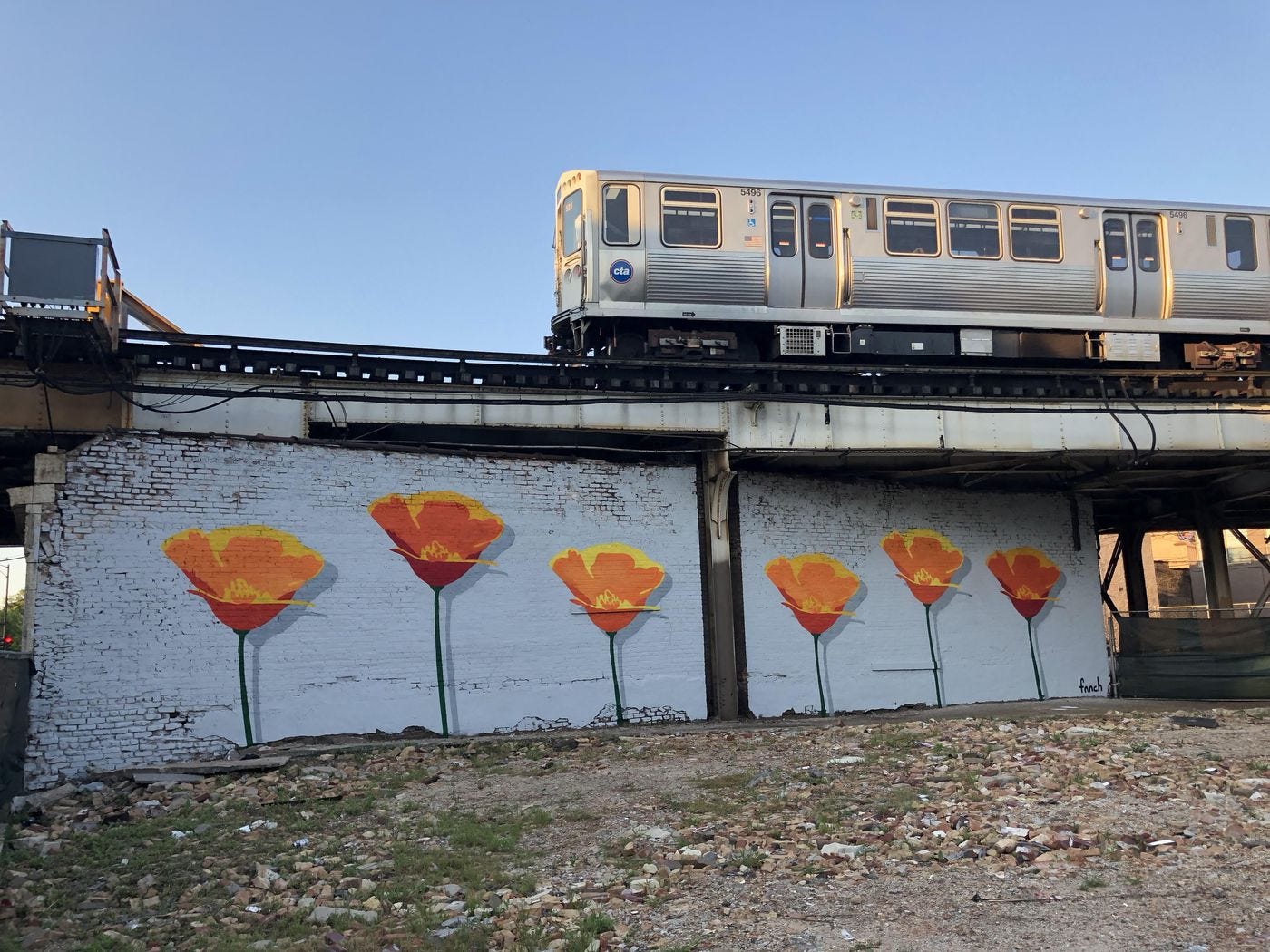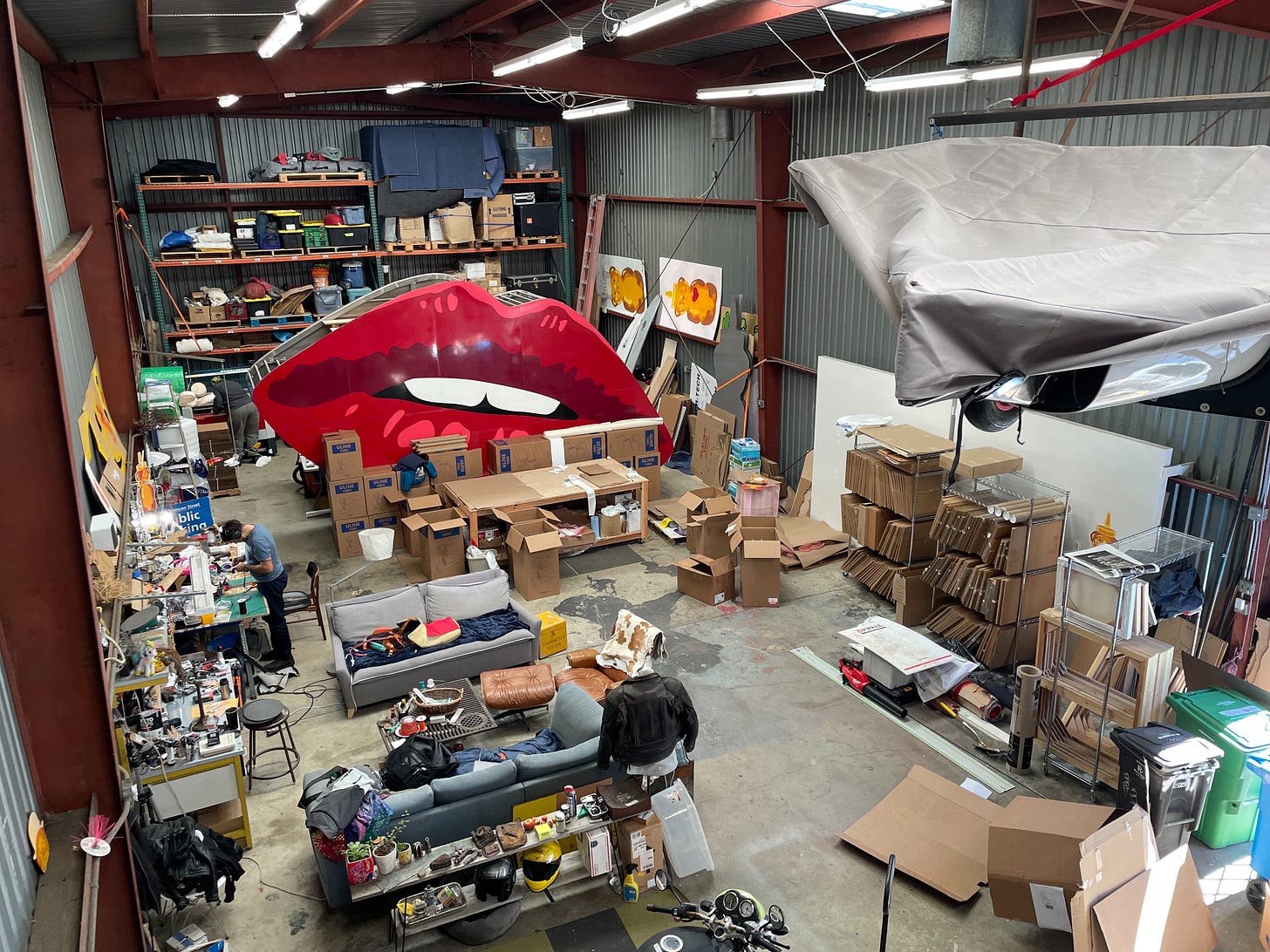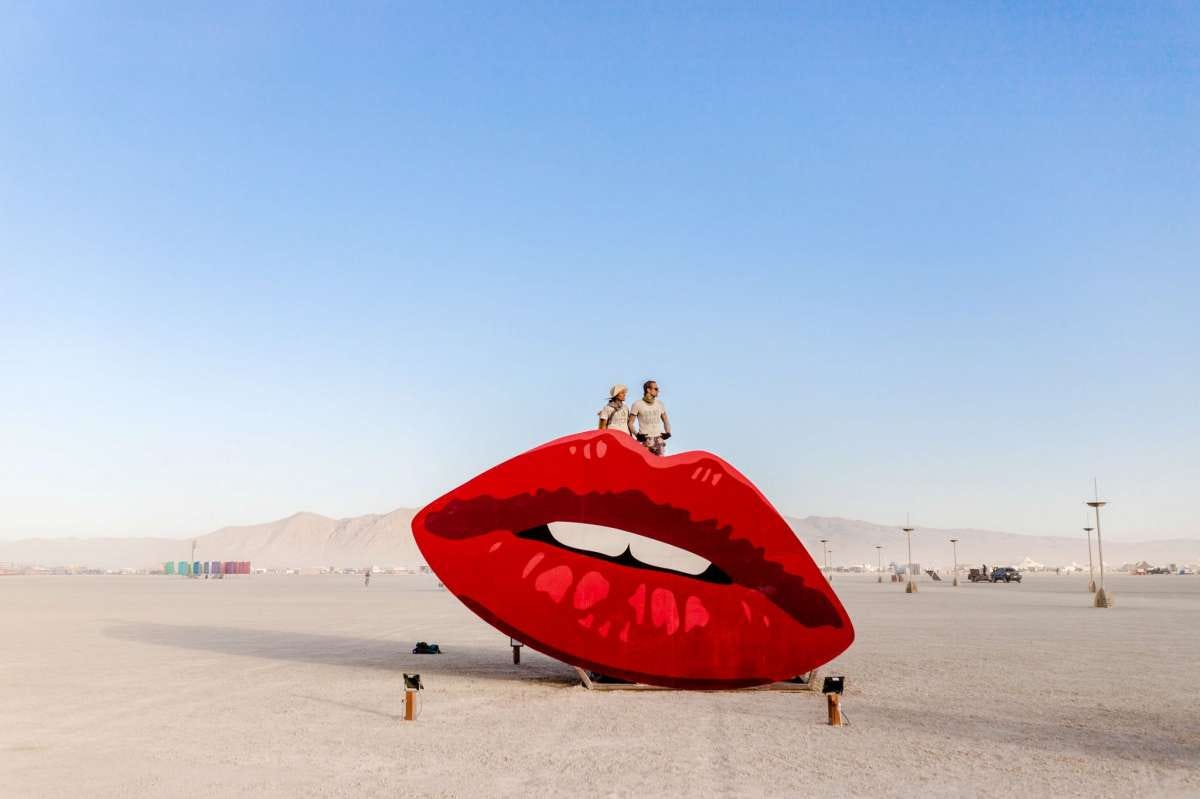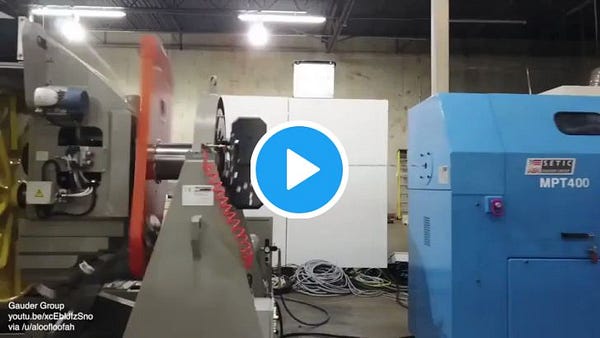MachinePix Weekly #32: fnnch, street artist
fnnch talks about his nom de guerre, the origin of the honey bear, and the machines that bottleneck his artistic process. This week's most popular post was a watermelon peeler 🍉
This week’s interview features fnnch, a mysterious and prolific street artist whose honey bears can be spotted around the world.
He recently published his 2020 year in review, and gave me a behind-the-scenes looks at his studio and the processes required to ship 15,000(!) paintings and prints.
The most popular post this week was a watermelon peeling machine. Lathe-like machines have been used to peel fruit for centuries.
I’m always looking for interesting people to interview, have anyone in mind?
—Kane
Interview with fnnch
What can you share about your life before fnnch (if there was one)?
I’ve kind of slowly opened up about this. It’s a bit weird. I’m from St. Louis, and I came to the Bay Area to go to Stanford and got degrees in Mathematics and Economics. I worked in the software world for a few years; my first thing was toys for the iPhone—not hard tech, not a game, just entertaining toys. I started doing street art in 2013 after moving to San Francisco and being inspired by what I was seeing around me. Slowly I just followed my opportunities there until I took the art full-time four years later.

Why “fnnch?”
Finch was my nickname in middle school. My two best friends were 5’9 girls and I was 5’0 and 100 lbs, hench “finch”.
My mom’s family also makes a lot of bird related artwork. I picked the spelling to get the handles on social media. I joke I’m too poor to buy a vowel. I’d rather have a vowel, but I didn’t know this would become a thing.
What was the original inspiration for the honey bears?
The honest truth is I was just looking at one and thought it was compelling. Early on I was just pursuing things of personal interest; there was no cohesive theme or idea. I was looking for images I thought were aesthetically compelling, and it turned out that the audience reaction to the honey bear was so profound that I ended up pursuing it more. Only later did I realize I could alter the image in a lot of ways; it wasn’t like I had a master plan for some pop art theme. I just found myself there and thought “this could be really compelling”.
Which variant has been the most popular?
I still feel like it’s the bear with the poppy in its hand. The poppy is the state flower of California, and people have come to associate the bear with San Francisco. Poppies are also an image I’ve painted alone, so the bear holding the poppy is like two of my pieces coming together into a single super piece.
I don’t have great intuition for what pieces will be popular. I don’t think anybody does actually—with any creative enterprise, you can only do things, put them out into the world, and wait for a reaction.
The variant I have is the MacBear Pro, where does that rank for you?
I really like it. It’s funny. I did a Wine Bear at the same time as the MacBear, and I thought for sure the MacBear would be more popular, but the Wine Bear sold twice as well! I think the MacBear is hilarious because the logo on the laptop is a bear head. It even has an emboss effect — it’s actually really hard to paint those tiny details.
How does a wood honey bear get made?
Cool, so: it starts with an order to a high end lumber yard for sheets of plywood. Those are delivered to a fabricator that operates a large and powerful laser cutter. For optimal utilization, I design the cuts for the full 4’ x 8’ sheet of plywood. I typically get 20 wooden bears per sheet.
One thing that’s interesting that happens before this: all the designs are drawn by me directly on a Wacom Cintiq into Adobe Illustrator. So they’re vector to begin with. All the art is done in the room I’m in now. No “art” happens after that, whether at the fabricator or in the studio.
Once the wood is cut, it’s picked up by an art assistant and delivered to my studio. We inspect each wooden bear for any cracks and fill them, and then sand down the front and back. Wood with too many blemishes is discarded.
It’s then put into a painting holder, which is a sheet of cardboard precisely cut for its shape. We coat the back with a clear coat to seal it and prevent warping.
The wooden bear is then flipped over and placed on a custom easel I’ve designed — the spray can wants to be vertical, so the wood hangs on these pegs at a slight angle, about 20%. The stencils hang on the same pegs: because everything is cut on a laser, the wood, the stencils, everything can be precisely placed. Well, almost: the thermal expansion of wood and cardboard are different, so there are some complications. I spray the first layer then place the bear onto a cafeteria baking rack. I designed and built my first drying rack, but then I discovered my templates were the size of cafeteria and baking trays, and there’s an entire industry that makes equipment for these, so I use those now.
We have about 80 paintings going at a time. If the paint is wet when the next stencil goes down, it imparts a texture into the paint. You can’t paint over that texture, because the spray goes on so thin, so if that happens the piece is thrown away. Hence so many paintings, to be sure they are totally dry. The process of putting the piece on the easel, hanging a stencil, filling it, and returning it to the drying rack happens many times. The average bear is perhaps 7 or 8 layers. The bear you have is 9, maybe 10 layers. Some layers are really tiny, some are big.
At that point, the paintings go through an inspection process to identify where they need to be touched up. They’re then clear coated and off-gassed at least overnight. They’re then inspected by me a final time, and I decide if it’s an editioned piece or an Artist Proof (AP). Any issues in the wood grain or paint, I put it aside. Those that pass inspection become signed, numbered pieces in the main edition, and the rest become APs. Someone then uses a laser-cut template to put the command strips on the back so they're in the same place every time. This way for shows, I can use a ruler to grid them on a wall precisely. I used to do it by eye with a laser level or measure tape, but it was very time consuming.
The bear then goes in a laser-cut holder, we package it and slap on a label, mailman comes three times a week and off it goes!
Do you cut the stencils yourselves?
At this point, we have a 24x40’ 90W laser in the studio for stencils. It actually broke recently and I had to fly someone in to fix it, which was unfortunate and very expensive.
When it comes to cutting the wood, it’s just not worth cutting it ourselves. You get much better packing on big sheets, the fabricator’s 400W laser cuts much faster. For stencils, it’s different. There's more time loading and unloading stencils than running the laser. There’s also a lot of them to cut. I say “cardboard is cheap, mistakes are expensive”, so if a stencil is getting a bit ratty, we just put it in the recycling bin. I have a bunch of sayings like that: “Paint is cheap, mistakes are expensive”; “Caps are cheap, mistakes are expensive”; “Tape is cheap, mistakes are expensive”. Why try to save $1 of cardboard and ruin a $500 painting? Right now, one stencil will do about 5 paintings, which is down from two years ago where one stencil did maybe 20 paintings. So we spend a lot of time on the laser cutter.
There are open source controllers for these lasers!
I’m tempted. Are you familiar with Otherlab? I visited, and they mentioned they’d written their own motion control software. I’m still learning; it’s tricky and there are a lot of things to take into account. For instance, the X-axis is very beefy because people use it to raster, but not the Y-axis. My best guess is the cutter is using an Euler approximation—not calculus—to figure out where it should go, so for small curves it stutters and destroys the machine’s efficiency. It’s frustrating, but I’m obviously scared to strip out parts and ruin the thing.
I’m surprised at this volume you laser cut packaging instead of die cutting.
Most of what we made last year were the bears for windows. Only after we did 12,000 of these by hand did I find a printshop to make a die, which dropped costs ⅔ and the improved quality. I wish I had done it much sooner.
You mentioned in a recent newsletter update that you sold a lot more paintings than you’d expected to 2020. How have you managed to keep up?
The main thing has been getting more help. So, what I do—what we do—is incredibly manual. To put things in perspective, we packed and shipped 15,000 items last year from a warehouse in the middle of San Francisco. That’s pretty fucking crazy. We’re making packaging, we’re packaging things.
I’ve been trying to understand what I can remove myself from and where I can actually add value. What I ask myself is: if somebody else did this thing, would it change the outcome? It turns out that’s almost never true. There are only few places where I actually change the outcome. At this point I should just design the art and figure out the stencils. Everything else can be done by fnnch Studios.
What kinds of processes and tools are used in the studio that people may not realize or appreciate?
We don’t do framed prints. Framing is more expensive than the print! It’s madness. Madness. This is why my main product I make is the wooden bears. I occasionally sell prints because I want to offer even more affordable artwork, but for the price of a print and a frame, you can buy an original painting from me.
When I started my art practice, I had five principles: one of them was everything had to be ready to hang, and unframed prints violated that. That’s why my main product is the wooden bears.
What were the wildest stories you can share from running your studio and painting your murals?
My first big wall mural was on a suspended scaffold. We’re in Midmarket, next to the food stamp location in San Francisco, and there’s always a cop hanging out down there. One day this woman narcs on her drug dealer right there in front of the police officer below us. It got super weird, super fast. We’re about 40’ up on this wall, on this rickety aluminum scaffold. It’s not exactly bulletproof. It ended up being ok, but it was a very uncomfortable situation.
Another crazy story was from 2019 when I was working on the Burning Man Lips piece. We were supposed to have a welding assistant, but she got super sick, so all the welding fell to my collaborator Stocky. We were running the studio about 18 hours a day, because the smoke from the welding interfered with the paint at a chemical level. So I had to come in insanely early to get my painting done before noon, and the welding would continue until about midnight. It was physically very challenging.
Do you have a favorite piece?
I did this piece called Cub of Bear, which is the painting of a bear with an apple in front of its face. It’s an homage to Son of Man by Magritte. It was done illegally at two in the morning. I like it because you either got the joke or didn’t—it was a mix of high and low brow.
What about a piece that you regret?
I don’t regret any piece. I’ve had things go horribly wrong, but I don’t regret anything. I would only regret something if I made the same mistake twice.
My goal is not to hit the ball, just to swing. I try not to associate my art with my ego. It’s not me, it’s just something I made. If people don’t like it, they don’t like it. It’s not a judgement on me. This relates to my point before: I don’t know what’s going to work. I just do the best I can.
Are you working on any side projects these days?
I’m noodling on a framing project to solve the framing cost challenge with prints. There are a few things that are outside the main things I do, it’s kind of like R&D. Similarly, I have an idea of a new way to make custom shaped canvases that I’m working on.
Favorite artists you’re following?
There’s a whole bunch. One I really like is @hybycozo: they do sort of platonic solids and other geometric shapes with cool patterns cut out of them and lights inside the project those patterns. You have to see it for that to make sense.
There’s another artist your audience might like: James Nolan Gandy (@gandyworks). It’s the most sophisticated... what are they called, when you’re a kid, with the gears, they spin around… spirographs! I’m obsessed with them.
There’s an artist out of NYC, Cj Hendry, I find her very interesting from a marketing standpoint. I find it interesting to follow her sensibilities, she does these very elaborate art shows. The whole thing is super interesting.
Any favorite books or books you’re reading right now?
I used to go through more books when I was in the paint booth more; now it’s a little bit slower. I’ll say it’s disappointing how many books I go through that aren’t that good, I recently went through a list I read last year and only two or three were really good. The most recent book I read that was pretty good was The Last Leonardo, about Salvator Mundi, the painting that sold for $450M at auction. You can’t make this shit up. Russian oligarchs, weird restorations — it’s a story that should be a film. It’s that level of absurdity.
If people are thinking about pursuing art professionally, the most useful book I’ve read was The $12 Million Stuffed Shark, a book on the art market by an economist. It’s the only book that’s helped me make sense of what I was observing in the world.
What’s your favorite simple (or not so simple) tool or hack that you think is under-appreciated?
The space pen. It will fit into the coin pocket of your jeans. It will actually write when you need it to. It’s not that expensive. I have one on me at all times. Having a pen on you is extremely useful.
The Week in Review
While researching this machine I found an ~incredible~ trade publication called Wire Times, which is rocking a sweet 90s internet aesthetic.
As you probably expect as a reader of this newsletter, there is a lot of nuance in engineering bricks.
Hovering a helicopter is non-trivial, and SmarterEveryDay has a great explainer as to why. Also I forgot it in the caption, but this is a Eurocopter EC145.

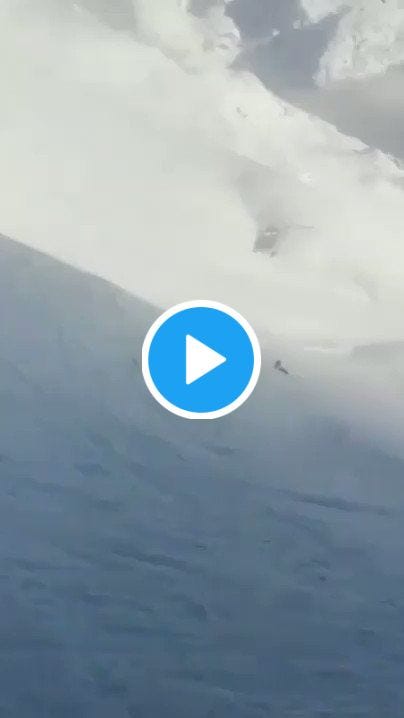
Postscript
If you enjoyed this newsletter, forward it to friends (or interesting enemies). I am always looking to connect with interesting people and learn about interesting machines—reach out.
—Kane






